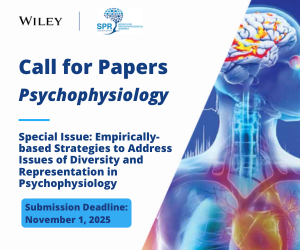Journal list menu
Export Citations
Download PDFs
Winner of the Presidents’ Pick Psychophysiology Paper Award for 2023: Simone Battaglia
Characterizing cardiac autonomic dynamics of fear learning in humans
- First Published: 07 June 2022
Understanding transient dynamics of the autonomic nervous system during fear learning remains a critical step to translate basic research into treatment of fear-related disorders. Here, using a novel frequency-based analysis to capture transient changes of heart rate variability, our findings highlight a selective modulation of the high frequency (HF) band of the power spectrum, when facing fear-relevant stimuli. Crucially, these results reveal specific increased parasympathetic (vagal) activity during fear learning in humans.
Early Career Award Article:
Pathways to depression: Dynamic associations between neural responses to appetitive cues in the environment, stress, and the development of illness
- First Published: 18 October 2022
This review summarizes research my colleagues and I have undertaken to understand the role neural responses to appetitive cues play in pathways to depression. I describe our work attempting to identify sources of variation in these neural responses and to understand how variation in these neural responses interacts with exposure to stressful life events to contribute to the emergence of depressive symptoms and disorders.
Celebrating the 60th volume of Psychophysiology:
The following is a collection of articles recently published in Psychophysiology, whose contents resonate with some of the themes of the 2023 SPR meeting program:
(1) Diversity, equity, and representation
Diversity and representation: Key issues for psychophysiological science
- First Published: 17 December 2015
Participant diversity in Psychophysiology
- First Published: 18 June 2023
Content analyses can help a field understand the impact of its policies or stated values. This paper outlines the reporting and use of demographic variables in articles published in Psychophysiology to trace the impact of SPR's commitment to DEI. Results indicate continued efforts are needed to diversify samples.
(2) Music
Relaxing effects of music and odors on physiological recovery after cognitive stress and unexpected absence of multisensory benefit
- First Published: 25 January 2023
The present study provides evidence that both musical and olfactory stimuli can help the autonomic nervous system regain homeostasis after cognitive stress. Unexpectedly, our research also shows the absence of multisensory benefit (“multimodal paradox”). These findings will contribute to our understanding of the underlying physiological mechanisms involved in the relaxing effects of musical and olfactory stimuli, presented separately or in combination.
Emotion elicitation during music listening: Subjective self-reports, facial expression, and autonomic reactivity
- First Published: 18 June 2021
Our findings add robustness to previous works demonstrating that standardized film music stimuli successfully modulated emotional reactions in laboratory settings, measured here by experiential, facial expression, and autonomic correlates. The current investigation also provides empirical evidence regarding the time course of peripheral physiology and combines both dimensional and categorical models of emotion as an advantage to understand affective processes.
(3) Periodic and aperiodic activity
Periodic and aperiodic contributions to theta-beta ratios across adulthood
- First Published: 25 June 2022
The fronto-central theta-beta ratio is negatively correlated with age, but it is unclear if this is due to age-related shifts in individual peak alpha frequencies, flattening of the aperiodic 1/f component, or a unique aging process. In a large adult sample (n = 268; age 36–84), the aperiodic exponent fully mediated the negative relationship between age and theta-beta ratio, suggesting theta-beta ratio and aperiodic exponent are highly confounded measures across the lifespan.
Early development of electrophysiological activity: Contribution of periodic and aperiodic components of the EEG signal
- First Published: 15 June 2023
Power of oscillatory brain activity recorded at rest (rs-EEG) provides reliable indicators of neurocognitive development. However, it conflates both aperiodic and oscillatory brain activity. We investigated age-related changes in rs-EEG activity in infancy and examined the contribution of aperiodic and oscillatory components of the signal to classic power measurements. We show that only alpha relative power was exclusively related to oscillatory activity, whereas aperiodic components contributed to the relative power in theta and beta bands.
(4) Machine learning
Identifying resting state differences salient for resilience to chronic pain based on machine learning multivariate pattern analysis
- First Published: 12 August 2021
This study is the first to identify regions of interest in which resting state brain activity discriminated more from less resilient chronic pain subgroups based on multiple kernel learning. Brain regions with the best discriminative power included regions implicated in pain processing, reward, executive function, goal-directed action, emotion regulation and resilience to mood disorders.
Are electrophysiological correlates of response inhibition linked to impulsivity and compulsivity? A machine-learning analysis of a Go/Nogo task
- First Published: 18 April 2023
Our findings add a new perspective to the effect and interaction of impulsivity and compulsivity on response inhibition through our linear and non-linear machine learning analyses. Although behavioral and electrophysiological alterations have been shown in clinical samples, we provide evidence that this cannot be simply applied to the general population, as no robust relationship emerged despite our large sample size.
Neuroanatomical predictors of real-time fMRI-based anterior insula regulation. A supervised machine learning study
- First Published: 15 December 2022
We delineated neuroanatomical predictors of the ability to self-regulate anterior insula cortex activity through real-time fMRI neurofeedback. Notably, we observed a major role of the cerebellum in predicting learned regulation of BOLD activity in the anterior insula. Our findings indicated a specific neuroanatomical topography relevant to emotional brain regulation, partially overlapping with the neurofunctional network associated with cognitive emotion regulation. Our neuroanatomical predictors might be ultimately exploited for designing patient-tailored interventions in emotional disorders.
(5) Bayesian approach
Does transcutaneous auricular vagus nerve stimulation affect vagally mediated heart rate variability? A living and interactive Bayesian meta-analysis
- First Published: 02 September 2021
Although vagally mediated heart rate variability has often been proposed as a biomarker for transcutaneous auricular vagus nerve stimulation, previous results are inconsistent and variable, leading to conflicting conclusions. Using a Bayesian random-effects meta-analysis that allows for continuous updates, we show that there is conclusive evidence for an absence of robust modulatory effects across a wide range of inclusion criteria for studies.
Valence precedes value in neural encoding of prediction error
- First Published: 13 February 2023
The reward positivity is generally described as encoding a reward prediction error but if it is to inform theories of human reinforcement learning its precise computational form must be described. Using mutually exclusive operationalizations, the present study suggests that a dichotomous good versus bad encoding precedes a quantitative signed prediction error in the interval of the reward positivity. The implications for reinforcement learning in humans are discussed in the light of separate mechanisms for negative and positive reward prediction errors.
(6) Addiction
Chronic non-medical prescription opioid use and empathy for pain: Does pain make the difference?
- First Published: 11 February 2021
Our study provides novel insights into empathy for pain in individuals with non-medical prescription opioid use (NMPOU) supporting social neuroscience models of empathy. Furthermore, the association with empathy for pain and heart rate variability in the NMPOU group suggests new implications for improved interventions of opioid dependence and long-term opioid treatment for pain.
Internal consistency and test–retest reliability of the P3 event-related potential (ERP) elicited by alcoholic and non-alcoholic beverage pictures
- First Published: 15 November 2021
P3/LPP responses to alcohol/drug cues are increasingly used as measures of individual differences in incentive salience attribution propensity, but limited attention has been paid to their psychometric properties. We provide evidence that alcohol and non-alcohol reward cue-elicited P3 responses, but not the difference between them, capture highly reliable and stable between-person variation. More work is needed to obtain psychometrically sound measures of addiction-specific between-person variation in the alcohol/drug cue-elicited P3/LPP.
(7) Speech
Who said what? The effects of speech tempo on target detection and information extraction in a multi-talker situation: An ERP and functional connectivity study
- First Published: 14 December 2020
Our results add a new perspective on extracting and storing information from a target speech stream in the presence of a concurrent speech. Behavioral, ERP, and functional connectivity data from the current study showed that speech processing is affected by the tempo of speech in a multi-talker situation. At slower speech tempos segregating the two speech streams and selection of the target stream required more processing capacity/effort, whereas, at higher speech tempos, processes related to target detection and the suppression of information interfering with this task became prominent.
Neural speech tracking shifts from the syllabic to the modulation rate of speech as intelligibility decreases
- First Published: 23 June 2023
Natural speech consists of both acoustic sound modulations and linguistic features, such as the rate at which syllables are expressed. Current investigations of neural speech tracking do not distinguish between low-level acoustic and linguistic information. Instead, the low-frequency acoustic modulations of speech are commonly simply equated to the production of syllables. However, while the temporal scale of the low-level acoustic modulations of speech is surprisingly stable across various speech settings (different speakers, languages, and speaking conditions) the production rate of syllables can differ across the same settings. We show that cortical regions track the syllabic rate, whereas subcortical regions track the modulation rate of speech. Furthermore, with declining intelligibility tracking of the modulation rate becomes overall more dominant.





